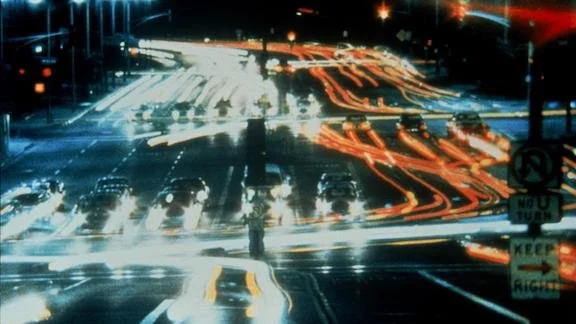Koyaanisqatsi
She rises from the Earth, radiant as the sun, her head a mass of roots, like the quintessential archetype of the Mother. Children haven’t forgotten her face, even if adults no longer remember.
“We come from hell. Not the Christian hell, or any other religion’s hell. We come from beneath the ground. She embraces that,” says filmmaker Godfrey Reggio, whose new film, Once Within a Time, recalls the long-ago myths, revealing them, and ultimately upending them to make way for something new. Not an easy task or a comfortable one, especially since this is a children’s film.
“It’s a very intense time,” says the 82-year-old Reggio, who lives in Santa Fe. “I think all of our myths are in question. We live in a burning world that’s in catastrophe now, but on a vital planet that’s alive, that breathes, that has its own myths. Your face and mine are part of it.”
Reggio’s thoughts come rapid-fire from a thin, bearded frame. The wall is thin between the imagery in Once Within a Time and the real-world crises that inspired the filmmaker’s poetic response in the first place. It’s one that sees him reunited with longtime collaborators composer Philip Glass and filmmaker Jon Kane.
Reggio is known internationally for films presented without narration and often scored by Glass, particularly his documentary trilogy Koyaanisqatsi (1982); Powaqqatsi (1988); and Naqoyqatsi (2002), which all derive their titles from the Hopi language. The films comprise a testament to the beauty of our planet and the destructive impact of our modern technologies. He receives the Santa Fe International Film Festival’s Lifetime Achievement Award at 6:30 p.m. on Oct. 22 at the Lensic Performing Arts Center, where his new feature receives its world premiere.
The live action images unfold on screen: the myth of the Tower of Babel, which Reggio perceives in the proliferation of technologies that divide us; the Garden of Eden, when the blame for humankind’s fall from grace was placed on Eve and not Adam, who ate the apple in the first place; and the Trojan Horse, the dark side of our technological age and the myth that even lends its name to an insidious aspect of our modern tech, the computer virus.
“The Trojan Horse, the snake — all of those myths we’ve turned upside down,” says Reggio, who’s first film Koyaanisqatsi(which means life in transition) screens for free at 2 p.m. on Oct. 21 at the Santa Fe Railyard Park (740 Cerrillos Road) as part of a Reggio retrospective. Other screenings include the 2013 film Visitors (2:30 p.m. Oct. 23, Jean Cocteau Cinema, 418 Montezuma Ave., $15) and the 1991 documentary short Anima Mundi (3:30 p.m. Oct. 21, Railyard Park).
His “Qatsi” trilogy approaches subject matter from a humanist perspective, but they’re didactic only in the sense that the dire consequences of unchecked technological advances and ambitions are plain in the contrasts revealed on screen.
Reggio is something of a modern-day Plato and is less interested in telling you what to think than in getting you to think. “Indeed, the question is the mother of the answer,” states the website for the Reggio-founded Institute for Regional Education, which was developed to promote a web dialogue on the themes of Reggio’s films, particularly around the nature of technology. “KOYAANISQATSI’s task is to raise questions that only its audience might answer” the site states.
But the question raised in Once Within a Time is critical to our identity as a people, as a planet, he says. Have we changed our reality to the point where we no longer recognize ourselves?
“Because we’re sensate, we become the world we live in,” Reggio says. “We are now becoming cyborg. Everything is predicated on the gizmo.”
The fantasy we’ve lost, and which is based in our direct experience with our environments, is what Reggio calls “a fantasy of the real.” It’s all of our myths, but our myths are grounded in our experience of nature and the world we live in, whether it’s the myths of the Old Testament or new myths born from the era of cellphones. Faced with cataclysmic, human-made disasters, the disruption on the outside reaches inside, where our myths once found a way to speak to us through our dreams. Now our myths are threatened with extinction, and the crisis is psychological.
“The children — not the children of the future because our children are our future — can resist this destiny of crazy normality,” Reggio says. “This film is a rebus; it’s a dream. And a rebus says, ‘not by word but by object, by act, by thing, by what we do.’ Our word no longer describes the world we live in.”
Reggio’s films are a passionate response to the state of our planet and ourselves. And he himself is passionate. He’s angry and concerned. But as much as his films address the problems we’ve created for ourselves, and which, one way or another, we’ll have to deal with, his outlook isn’t dour.
“This film, Once Within a Time, is not a fairy tale,” Reggio says. “This is the bardic tale. The bard is the person who cannot help but feel and be touched by the suffering of others, and suffering is everywhere. We can avoid it if we create our own world. This is so important. Those that are courageous enough to be hopeless about this world have the courage to be hopeful about creating their world.”
By Michael Abatemarco

